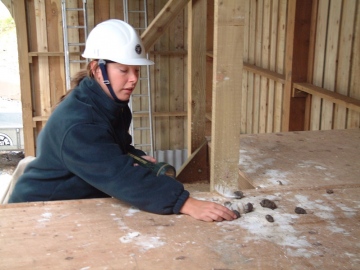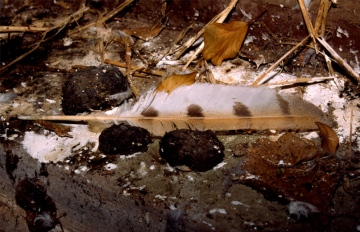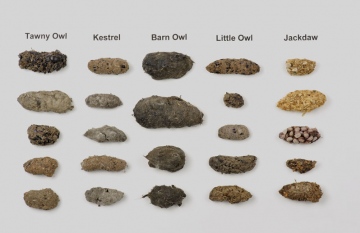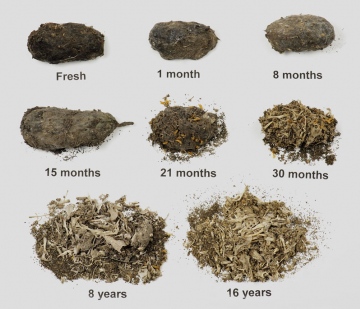Identification Guide - Owl Pellets
Where were the pellets found?
Most Barn Owl pellets are found inside roost and/or nest sites (e.g. in buildings, tree or rock cavities).
Pellets found outdoors are much less likely to be from a Barn Owl unless they are directly below an entrance hole (e.g. a hole into a tree cavity or nestbox) or a well-used hunting perch.
Here are examples of two pellets found outside:
a Buzzard pellet and a Kestrel pellet.
What species of bird produced the pellets?
Bird pellets found inside buildings or tree/rock cavities in the countryside are most likely to be from Barn Owl, Little Owl (but not generally in Scotland or most of Wales), Tawny Owl (not Ireland), Kestrel, or Jackdaw. This is because the other species of owls, raptors, and corvids that occur in Britain and Ireland do not frequent such places. Click image to view full size:
Barn Owl pellets are usually wider and more uniform in colour.
Feathers as further evidence
You may notice feathers amongst the pellets. Here are two pictures you may find helpful: Barn Owl feathers and other bird feathers found in buildings. Click images to view full size.
Unusual pellets
Here are some examples of very unusual Barn Owl pellets; showing wing feathers, protruding bone, a Woodcock skull and lastly, soggy pellets. Pellets lying in wet places do not last long and these soggy Barn Owl pellets will soon be gone. Click images to view full size.
Pellet ageing
Virtually all Barn Owl pellets are black and wet when they are fresh. Extremely fresh pellets may even blacken your fingers slightly like this. Those lying undisturbed in dry places (e.g. outbuilding or dry tree cavity) usually take about 2 years to fall apart. This picture provides a guide to ageing Barn Owl pellets, click to view full size.
Barn Owl nest debris and carcasses of dead owls (in dry places) can also be aged. The Barn Owl Conservation Handbook ![]() provides a detailed guide on this and all other aspects of Barn Owl surveying.
provides a detailed guide on this and all other aspects of Barn Owl surveying.
Perhaps it’s not a pellet at all?
Fox faeces are quite often found in farm buildings. Because they often contain hair and sometimes bone they can be confused with owl pellets (their smell becomes much less noticeable as they dry). Click images to view full size.
NOTE: Virtually all birds that swallow indigestible items regurgitate pellets (raptors, fish-eaters etc.) – not just owls.
If you are 100% certain that the owl you saw really was a Barn Owl and you don't know where it roosts or nests, please complete the Random sighting survey form.
If you do know where it roosts or nests please complete the Roost or nest site survey form.
back to Owl identification















